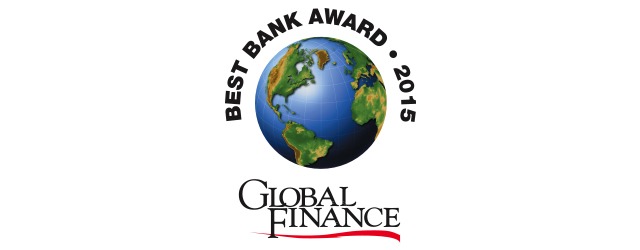Global Finance unveils its annual list of the best banks globally, regionally and by country. The winners have provided the best service to clients.

Introduction | Ready For The Next Crisis |
Winners | Global & Regional Winners | Country Winners: Developed Markets | Country Winners: Emerging Markets |
Profiles | Global Winners | Regional Winners |
Back To Coverage
READY FOR THE NEXT CRISIS
By Gordon Platt
Global Finance unveils its annual list of the best banks globally, regionally and by country. The winners have provided the best service to clients.
In the world of banking, necessity has proved to be the mother of contention. While banks have bristled at the regulations imposed in the wake of the Great Recession, they are stronger for having met those requirements. Many have amassed more capital to help ride out economic shocks. They’ve also exited risky proprietary trading. Scores of banks have downsized and simplified their operations to concentrate on core geographies and businesses. In general, banks are also less dependent these days on wholesale funding, which froze up quickly in the last crisis.
Nevertheless, the volatility in global financial markets in recent months has exposed cracks in the system. With fewer market makers to smooth sudden, big moves, investors in equity and fixed income securities have found themselves trapped on a rollercoaster.
According to business intelligence firm SNL Financial’s latest ranking of banks by assets converted to dollars, there’s been a major shakeup in the top tier of the biggest global banks. China now has four of the top five largest banks in the world, after weakening currencies pushed French and Japanese banks off the upper end of the list. The rise of Chinese financial institutions hasn’t particularly hurt global banks, which are largely shut out of the market in the People’s Republic. And Fitch Ratings says China’s recent sharp stock market correction is unlikely to substantially impact the balance sheets of Chinese banks or to pose a systemic risk to the global banking sector. Fitch notes that China’s banks are not allowed to grant loans to customers who intend to engage in margin lending.
Direct cross-border lending by banks worldwide has declined as a share of total banking assets since 2008, largely reflecting a retrenchment by European banks, according to the International Monetary Fund. The pullback has been triggered by tightened regulations on banks’ international operations. Local and regional banks have stepped in to take up some of the slack, the IMF says. Those international banks that continue to lend across borders are doing so more often through overseas branches and subsidiaries than directly from the parent institution.
“Strengthened regulatory frameworks are helping to make financial institutions and the global financial system more robust,” the IMF says in its latest Global Financial Stability Report, released in June. Cross-border lending flows are more sensitive to global volatility, whereas lending by foreign subsidiaries is more resilient, the IMF says. The Fund recommends a multinational banking model based on local subsidiaries, rather than a cross-border one directed from the home country of the lender.
Foreign banks operating locally tend to pull back credit less than cross-border lenders following economic shocks in host countries, according to the IMF. Indeed, banks operating locally via subsidiaries or branches tend to be less sensitive to changes in capital flows owing to global contagions, it says. Still, cross-border lending helps to allocate savings efficiently, and there should be international cooperation on regulations and standards to make it safer, the IMF recommends.
LINKED IN
Meanwhile, intraregional financial linkages have deepened in Asia. The connections have heightened exposure of Asian banks to shocks emanating from within the region. Those ties have also ramped up the speed with which outside disturbances can spread throughout the region, according to the IMF.
In the US, the second-quarter earnings of large American banks were better than projected, says Brian Monteleone, credit research analyst at Barclays. “Revenues exceeded expectations, and pretax income surprised on the upside,” he says. “Both posted sequential increases, despite lower capital market revenue. Asset quality trends remained favorable and capital rose.”
Higher net interest income and lower provisions and expenses drove the improvement in bottom-line results, Monteleone says. “Positive earnings, combined with smaller balance-sheet size, resulted in higher tangible common equity and fully phased-in Basel III capital ratios,” he says.
Europe’s banks also reported impressive second-quarter earnings. On average, net income rose by 35% from the same period a year earlier. The European Central Bank’s July 2015 bank lending survey, covering the second quarter, showed that changes in lending conditions—and rising loan demand—supported a further recovery in bank credit in the euro area. Credit standards on loans to enterprises continued to ease in France and even more so in Italy. Competition was the main factor cited for the lowering of the borrowing standards.
Conversely, emerging-markets bank lending conditions continued to tighten in the second quarter. The Institute of International Finance’s composite index for such lending conditions rose by 0.9 point in the second quarter but stayed below 50. That implies that bank conditions continued to tighten, albeit at a more moderate pace. “This worsening of supply conditions has largely offset more positive news of higher loan demand, notably in emerging Europe,” notes Felix Huefner, chief economist at the IIF.
RATE WAIT
Senior executives at most financial services companies around the world appear to believe that their banks are well positioned to achieve strategic targets, according to consultancy EY’s review of key themes discussed during second-quarter earnings calls. Many also say they have the right business model in place to drive sustainable performance. The lion’s share of the banks included in EY’s report—which was released in August—recorded year-over-year gains in earnings, revenues and return on equity. That extended positive trends seen in the first quarter.
Management at a number of banks said that macroeconomic challenges are easing or, at least, becoming more manageable, EY says. Challenges remain, though, most notably the resolution of legal and conduct issues and the cost of complying with regulations and potential new rules.
In Europe, especially, the benefits of quantitative easing were evident in improved results. Managers at US banks continued to operate under the assumption that the Federal Reserve would begin to increase interest rates before the end of the year, according to the EY report. For the first time in many quarters, management at European banks commented on economic improvements—or at least stabilization—in the eurozone.
The EY survey found that despite positive trends on efficiency, bank executives remain focused on expenses and cited elevated regulatory costs as one of the primary barriers in achieving further improvements. “Notably, the cost of compliance is a universal headwind for the industry, regardless of business model or domicile,” the professional services firm indicated. In addition, most banks would prefer to invest in their current businesses to drive organic growth, rather than making acquisitions, EY says.
In our 22nd annual survey, Global Finance selected the best banks in 143 countries and eight regions of the world. We also identified the best global banks in various service categories. This listing includes the best banks worldwide for emerging markets, frontier markets, global custody, subcustody and Islamic finance. The winners in each category are being announced here for the first time. Other previously announced awards for corporate, consumer and investment banking, asset management for corporates, cash management, trade finance and foreign exchange are also featured.
The winners are not necessarily the biggest banks, but rather the best banks—those with the qualities that corporations should look for when choosing a bank. These banks offer superior service, the most-effective risk-management systems and the best products. They constantly invest in best-of-breed solutions and staff to outperform their peers.
We chose the winners based on performance over the past year, as well as subjective criteria, including reputation and management excellence. Global Finance made the selections after extensive consultations with bankers, corporate financial executives and analysts worldwide.
Back To Coverage
GLOBAL WINNERS | REGIONAL WINNERS | US WINNERS
Back To Coverage
DEVELOPED MARKETS | EMERGING MARKETS
Back To Coverage
WINNER’S PROFILE
Global Winners | Regional Winners
GLOBAL WINNERS
BEST GLOBAL CORPORATE BANK
Mitsubishi UFJ Financial
Japan’s biggest bank and the world’s second-largest bank holding company in terms of market cap, with $2.5 trillion in assets, Mitsubishi UFJ Financial (MUFG) spans 40 countries. Its 2008 acquisition of 21% of Morgan Stanley gives it unusual global heft. Mitsubishi UFJ Morgan Stanley was the top financial adviser in 2014 for Japan-related mergers and acquisitions, according to Dealogic. Corporate and investment banking products range from samurai loans (yen-denominated, cross-border syndicated loans for non-Japanese borrowers) to acquisition finance, ship finance and asset-based lending.
Last year MUFG integrated the US operations of its Bank of Tokyo-Mitsubishi UFJ (BTMU) unit with its San Francisco-based Union Bank to create MUFG Union Bank, one of the largest foreign banks in North America. BTMU has worked in Latin America for nearly a century. Its London headquarters run 46 offices in 20 countries in Europe, the Middle East and Africa.
It has a long- and short-term focus on business development based on attention to changing customer needs, challenging the competition and boosting productivity.
—Nobuyuki Hirano, president and CEO
www.mufg.jp
BEST GLOBAL CONSUMER BANK
BBVA
BBVA, a Spanish bank with $750 billion in assets, has a large global footprint and a leadership position in the tech-driven transformation of financial services. This year BBVA bought Spring Studio, a San Francisco-based user-experience and design firm, to help meet its goal of becoming the world’s best digital bank as well as the top developer of banking software.
Through its North American subsidiary, BBVA Compass, it has a major presence in the US Sun Belt, with 672 branches in seven states. The bank recently introduced a new mobile-banking app with increased functionality and easier navigation. BBVA also operates in Latin America, Asia-Pacific and the Middle East.
BBVA had 4.3 million mobile customers at the end of 2014. It has invested heavily in a cutting-edge technology retail platform to develop a new generation of services to compete with start-ups and tech giants like Apple, Google and Amazon. BBVA has 450 people working on BBVA Wallet, a popular app for mobile payments. BBVA Ventures, its private equity subsidiary, participated in Coinbase’s most recent $75 million funding round.
—Francisco González, chairman and CEO
www.bbva.com
BEST ISLAMIC FINANCIAL INSTITUTION
Al Baraka Banking Group
The Bahrain-headquartered banking group maintains operations in some of the most challenging markets in Northern Africa and the Middle East, including Syria, Tunisia, Libya, Egypt and Iraq. Despite the faltering economic and political status of some of these countries in the wake of the Arab Spring, Al Baraka continues to post encouraging financial results in these markets. In the first quarter of this year, the group’s net income reached $69 million, a 3% increase over the previous year. The bank attributes diversification of income sources for its ability to maintain steady growth. Al Baraka is also playing a key role in financing trade between the Middle East and North African countries. A $268 million syndicated murabaha financing facility, which closed in April and was oversubscribed, will be used by the bank to strengthen its funding base and network of banking relationships.
—Adnan Ahmed Yousif, president and CEO
www.albaraka.com
BEST EMERGING MARKETS BANK
ING
ING, a multinational bank based in the Netherlands, has shown strong financial results in recent years and continues to empower its customers through innovative systems and products, particularly in Central and Eastern Europe. The bank’s e-commerce platform, ALEO, enables small and medium-size enterprises in Poland to buy and sell merchandise and services online. It offers auctions and a payment system. ING continues to expand its digital offerings and has a broad presence in the CEE region. The bank is also making a concerted effort to expand its commercial banking operations in Asia, at a time when other European banks are scaling back. In addition, ING is working with Asian corporates to help them set up treasury centers in Europe.
Ralph Hamers, CEO and chairman
www.ing.com
BEST FRONTIER MARKETS BANK
Standard Bank
Standard Bank, Africa’s biggest bank by assets, operates in 20 countries on the African continent. Since 2000, Africa’s economy has averaged more than 5% real GDP growth annually. Although growth has slowed somewhat this year, sub-Saharan Africa remains one of the world’s fastest-growing regions. Standard Bank’s earnings rose by 27% in the first half of 2015, and its credit loss ratio declined to less than 1%. The bank’s Tier 1 capital adequacy ratio was 13.7%, up a full percentage point from a year earlier. Standard Bank has been introducing innovative products across the continent, including mobile banking and lending programs for small and medium-size enterprises.
—Ben Kruger and Sim Tshabalala, joint CEOs
www.standardbank.com
BEST ASSET MANAGEMENT FOR CORPORATES
Deutsche Asset & Wealth Management
With roughly $1.4 trillion in assets under management, Deutsche Asset & Wealth Management ranks among the 10 largest bank-owned asset managers globally. The asset management division has a presence in 40 countries; the group on the whole is active in 71 countries. Not surprisingly, the firm stands out for its worldwide reach, which provides clients with both a global perspective and local knowledge. Deutsche AWM, which runs a sizable corporate asset management operation, is a big player in alternative investments, particularly real estate. It’s well known for product innovation.
—Michele Faissola, head
https://deutscheawm.com/
BEST CUSTODY BANK
BNY Mellon
BNY Mellon, the world’s largest custody bank, had assets under custody and/or administration of more than $29 trillion. In June, the bank signed an agreement with T. Rowe Price to provide portfolio and fund accounting services to the asset manager. The deal added approximately $770 billion to BNY Mellon’s custody and administration assets. The bank has a global presence, serving more than 100 markets in 35 countries. It also is the world’s largest depository for American and global depositary receipts. BNY Mellon’s investment management services have grown sharply since the global financial crisis, as stricter regulatory requirements have convinced many financial institutions to turn to custody banks to handle their middle-office and back-office functions.
—Gerald Hassell, chairman and CEO
www.bnymellon.com
BEST SUBCUSTODY BANK
Citi
Citi Direct Custody and Clearing has the largest proprietary custody network in the industry, covering 62 markets worldwide. The bank’s global platform and procedures ensure a consistently high level of performance in all of its markets. Citi’s securities specialists on the ground are adept at handling any difficult situations that may arise. While the industry’s current operating environment is challenging, Citi is becoming more and more efficient through the continuous upgrading of its technology. The bank goes the extra mile to customize its solutions to meet the needs of its diverse customer base. Citi offers a proprietary mobile platform with detailed information on fund flows and local market practices.
—Lee Waite, global head of direct custody and clearing
www.citigroup.com
BEST INVESTMENT BANK
J.P. Morgan
J.P. Morgan led the titans of Wall Street in attracting corporate clients in markets of all sizes around the world with not only the vast reach of its global distribution capability but also the strength of its balance sheet. Taking full advantage of the relative capital weaknesses of its peers, J.P. Morgan judiciously stole market share—21.5% in mergers and acquisitions, 7.5% in equity and 6.7% in debt—from both global European peers and relatively small local banks scattered across frontier and emerging markets. Playing to corporate bond issuers who were under pressure to take on as much cheap debt as possible in a low-yield environment, J.P. Morgan raised $421 billion in no less than 1,771 public debt issues for its clients last year.
—Jamie Dimon, chairman and CEO
www.jpmorgan.com
BEST CASH MANAGEMENT BANK
Citi
Citi focuses on providing a best-in-class consultative approach. Hubert Jolly, Citi’s global head, channels, enterprise and account services, treasury and trade solutions, says: “Combined with our digital strategy focused on mobile- and tablet-based solutions, acknowledgments like these endorse Citi’s position as an innovative market leader providing the most-advanced treasury solutions to our clients around the world.”
—Michael L. Corbat, CEO
www.citigroup.com
BEST TRADE FINANCE BANK
HSBC
The Hongkong and Shanghai Banking Corporation was established in 1865 to support trade between China and Europe. Today UK-based HSBC is the largest foreign bank in China. Moreover, the bank boasts tremendous reach, operating at both ends of the top 15 trade corridors in the world.
Case in point: HSBC was the first international bank to support renminbi trade transactions on six continents. It is able to execute trade deals in renminbi in the more than 50 countries in which it offers trade finance. Of note, HSBC expects one-third of China’s trade to be settled in renminbi by the end of this year.
In Britain, HSBC was the first bank to formalize a trade initiative with the British government to advise businesses on export-related matters. HSBC is a principal partner of the government’s “Open to Export” service, which offers support and advice to small and medium-size enterprises.
In Canada, HSBC has the highest import and export market share by volume of documentary credits, according to the Canadian Bankers Association. The bank uses its global network to issue overseas guarantees without having to negotiate prices with other banks.
HSBC merged its trade, supply-chain and receivables financing units four years ago. The bank’s online banking solution, HSBCnet, includes a trade module for initiating transactions, amending documents and accessing current information about trades.
—Stuart Tait, head of global trade and receivables finance
www.hsbc.com
BEST FOREIGN EXCHANGE BANK
Citi
Citi is present in 100 countries, 68 of which are emerging or frontier markets. As the main global bank serving large multinational corporations, Citi has steadily increased its foreign exchange volume in recent years to become the largest FX bank in the world. Aggressive pricing and innovation are part of the reason for Citi’s growing market share in the foreign exchange arena.
The bank’s new automated renminbi cross-border sweeping structure enables clients to move end-of-day balances from China, Hong Kong and Singapore to London, the center for managing currency risk. The global concentration platform enables customers to integrate renminbi efficiently into their treasury and liquidity operations.
The CitiFX Pulse platform for corporations enables multinationals to track cash flow and balance-sheet exposure across their worldwide subsidiaries. This Web-based tool makes it easier for corporations to assess overall risk exposure and implement necessary hedging programs.
Citi has other strengths as well, including the bank’s ability to handle and advise on large transactions. Its experienced staff, with access to liquidity, can price large trades without moving the market. Citi has the expertise to structure complex deals in a wide range of industries. It has also developed systems to manage the extensive documentation required by FX regulations in many countries.
—Nadir Mahmud, global head of FX and local markets
www.citigroup.com
Regional Winners
Best Bank In North America
Wells Fargo
Wells Fargo, the world’s largest bank by market capitalization, has benefited from conservative risk-management policies and a diversified business model. The bank’s revenue is balanced between net interest income and fee-based income. Wells Fargo earned a record $23.1 billion in 2014, a 5% increase from a year earlier. Performance will likely be about the same in 2015, as Wells Fargo generated $11.5 billion in net income in the first half of the year.
From its San Francisco base, the bank has expanded to become a nationwide financial institution. While most of its assets are in the US, Wells Fargo now operates in 36 countries.
Wells Fargo is using its sustained earnings strength to return more capital to shareholders. It purchased 87 million of its shares on a net basis last year. The bank’s credit losses have remained near historic lows, while nonperforming loans have declined. Wells Fargo leads all US banks in small-business lending, home mortgage customers, auto lending, agriculture-related loans and commercial real estate financing. It focuses on what it calls the “real economy,” rather than on trading and speculative activities.
Wells Fargo, long a leader in international trade finance, is the largest import factor worldwide. Its supply-chain finance unit offers products to large corporations and their trading partners to help manage cash flow and increase market share.
—John Stumpf, chairman and CEO
www.wellsfargo.com
BEST BANK IN WESTERN EUROPE
ING
ING posted a strong set of 2014 results. The bank made big strides in empowering its customers through innovative systems and products, these forming part of a seamless multichannel offering supported by simplified and more-cost-efficient processes.
It also successfully shed more noncore businesses, made the final repayment of its bailout funding to the Dutch state and reinstated its dividend. Chief executive officer Ralph Hamers notes that ING “comfortably passed the ECB’s latest comprehensive assessment” and that “the outcome reflects our strong capital position and resilient balance sheet.” Indeed, the bank’s Tier 1 capital ratio rose from 10.4% to 11%, fully loaded. Underlying net profit was up by 8.5% to more than €3.4 billion ($3.6 billion), driven by higher net interest income and lower risk costs. That trend is continuing. In the second quarter of 2015, ING reported a 10.3% year-over-over hike in underlying income.
Vice chairman Koos Timmermans adds that in 2014 “we introduced initiatives to help people gain a better insight into their finances. We also supported customers’ financial needs as well as SMEs’ and large companies’growth with €15 billion of new lending.”
—Ralph Hamers, CEO and chairman
www.ing.com
BEST BANK IN NORDIC COUNTRIES
Nordea Group
Nordea has the region’s largest banking platform. The bank also either leads or ranks second in market share in all Nordic countries. Group CEO Christian Clausen says that, “despite a challenging economic environment, Nordea delivered improved revenues and lower costs leading to increased profitability.” The bank’s operating profit increased by 9%. At the same time, costs were about 4% lower. That reduced the company’s cost/income ratio to 49%. Clausen notes that Nordea attracted more new customers and further strengthened its capital position, its Tier I capital ratio improving by 1.8 percentage points to 15.7%.
”We also took the next step,” he says, “in the transformation to meet our customers’ changing behavior and the new regulatory requirements. To facilitate the development of more personalized customer solutions and systems that efficiently fulfill the increasing monitoring and reporting requirements under the new regulation, we are simplifying processes in all parts of the bank. As part of this process, we will increase our IT investments by 30% to 35% over the coming years and build new core banking and payment platforms, significantly increasing our agility, benefits of scale and resilience.”
The company announced in August that Casper von Koskull will be taking take over the reins as Nordea’s president and group CEO starting on November 1, succeeding Clausen.
—Christian Clausen, president and Group CEO
www.nordea.com
BEST BANK IN CENTRAL & EASTERN EUROPE
Raiffeisen Bank International
CEO Karl Sevelda notes that “RBI operates a strong business model and franchise in the CEE” and in 2014 operated profitable banks in 12 of 15 CEE markets. It also sets the bar in many of its markets for standards of service and innovation, most notably in Slovakia. But the geopolitical crisis in Ukraine called for an increase of about €412 million ($462 million) in provisioning for impairment losses, accounting for most of the €567 million the group set aside in total for the year. Net interest income rose by 2%.
Sevelda points out that “the bank kept its earnings at a high level while reducing costs by 10%.” After more than €1.7 billion of provisions (a 49% increase) and an €251 million one-off legislative charge in Hungary, RBI remained profitable—although the pretax result dropped from €835 million to €23 million. The bank’s common equity Tier I capital ratio rose by 0.2% to 10.9%. RBI’s adapted strategy, says Sevelda, will “further strengthen its capital position, improve its risk profile, and reduce complexity as well as costs.”
—Karl Sevelda, CEO
www.rbinternational.com
BEST BANK IN LATIN AMERICA
BBVA
BBVA has a stated goal of building the best digital bank of the 21st century, a target that is helping transforming the way Latin American banks do business. The bank is investing $2.5 billion in its Latin American operations through 2016 in a bid to become the region’s top digital bank. The plan, launched in 2013, is aimed at making BBVA a totally digital company, including all products and services. BBVA operates banks in Argentina, Chile, Colombia, Paraguay, Peru, Uruguay and Venezuela, as well as a pension fund manager in Bolivia. Latin American operations generated €3 billion ($3.2 billion) in net attributable profit in 2014.
—Francisco González, chairman and CEO
www.bbva.com
BEST BANK IN ASIA-PACIFIC
ANZ Group
It’s tough to find a corner of finance in the Asia-Pacific region where ANZ has not made its mark. ANZ operates in 29 countries across the region and is looking to complete the set by starting up operations in Myanmar and Thailand.
ANZ is one of the leading loan houses in Asia, ranked second only to Standard Chartered in 2014, with 57 deals totaling $7.5 billion in G3 (euro, dollar, yen) currencies, according to Dealogic.
With one of the largest loan syndication teams in the region, ANZ is in position to leverage this franchise to continue expanding its presence in acquisition finance, export and project finance and corporate advisory services.
One segment ANZ wants to capture is acquisitions of Australian business by companies in the greater China region. There should be no shortage of such deals. The Australian dollar remains weak, and the drop in global commodity prices has made many corporations in the country attractive takeover targets.
The bank is also trying to translate regional expansion into better electronic banking service for corporate customers. In early March, ANZ won Celent’s Model Bank Award for payments innovation as it has expanded its common platform across the region.
The bank appears to be set for some changes. As of late March, ANZ had been mulling a buyout of the Asian regional assets of Royal Bank of Scotland, which is in the midst of downsizing. Any acquisition would help ANZ compete against much bigger global rivals HSBC and Citigroup. In addition, Group CEO Michael Smith is planning to step down at some point in the next two years. The head of the company’s Australian unit, Philip Chronican, retired earlier this year.
—Michael Smith, CEO
www.anz.com
BEST BANK IN THE MIDDLE EAST
National Bank of Kuwait
National Bank of Kuwait has kept a close watch on asset quality, and its conservative approach to lending has paid off during a period of political turmoil in the Middle East. NBK stands to benefit from its preeminent position in its home market, as Kuwait’s non-oil growth accelerates an expected 5% to 6% this year and next. Capital spending under the government’s long-delayed development plan has finally begun to boost economic activity outside of the petroleum sector. NBK is playing a major role in the financing of these huge infrastructure projects.
NBK’s long-term strategy is to maintain its leading position in Kuwait, while leveraging its well-known brand throughout the region. The bank has a presence in Bahrain, Egypt, Iraq, Jordan, Kuwait, Lebanon, Saudi Arabia, Turkey and the United Arab Emirates.
NBK Group posted a 10% rise in earnings in 2014, while its assets increased by 17.1%, to more than $74 billion. The bank remains on track this year, posting a nearly 13% year-over-year hike in net profits in the first half of 2015—despite the continued slump in the country’s oil sector. Likewise, NBK has proved resilient throughout its transition to new management and has set clearly defined goals across a product and service range that includes corporate finance, investment and wealth management, and retail banking.
—Isam Jassim Al Sager, group CEO
www.nbk.com
BEST BANK IN AFRICA
Standard Bank
In February, Standard Bank, Africa’s largest bank by assets, sold a 60% stake in its London subsidiary to Industrial and Commercial Bank of China. The proceeds from the deal, roughly $765 million, will be used to further strengthen Standard Bank’s operations in Africa. The Johannesburg-based bank has operations in 20 countries on the continent, where it has been introducing innovative products, such as contactless cards and mobile payment solutions. Offerings released last year include PayPlus in Ghana, Till2Bank in partnership with M-Pesa in Kenya, and iServe in Malawi.
Standard Bank is distributing insurance and new risk products for the African market, where only 3% of the population has any form of coverage.
Within South Africa, Standard Bank’s AccessBanking mobile solutions have attracted 10 million new customers. Most live far outside major cities in townships that don’t have physical bank branches.
Standard Bank posted a 20% rise in earnings from continuing operations in 2014 and raised its dividend by 12%. The bank’s net interest income rose 15%, and it lowered its loan-loss provisions by 2%, as nonperforming loans outside of South Africa declined. South Africa’s economy, which was hit by mining strikes and electricity shortages, grew only 1.5% last year. But GDP growth in sub-Saharan Africa was 5%.
—Ben Kruger and Sim Tshabalala, group CEOs (joint)
www.standardbank.com



